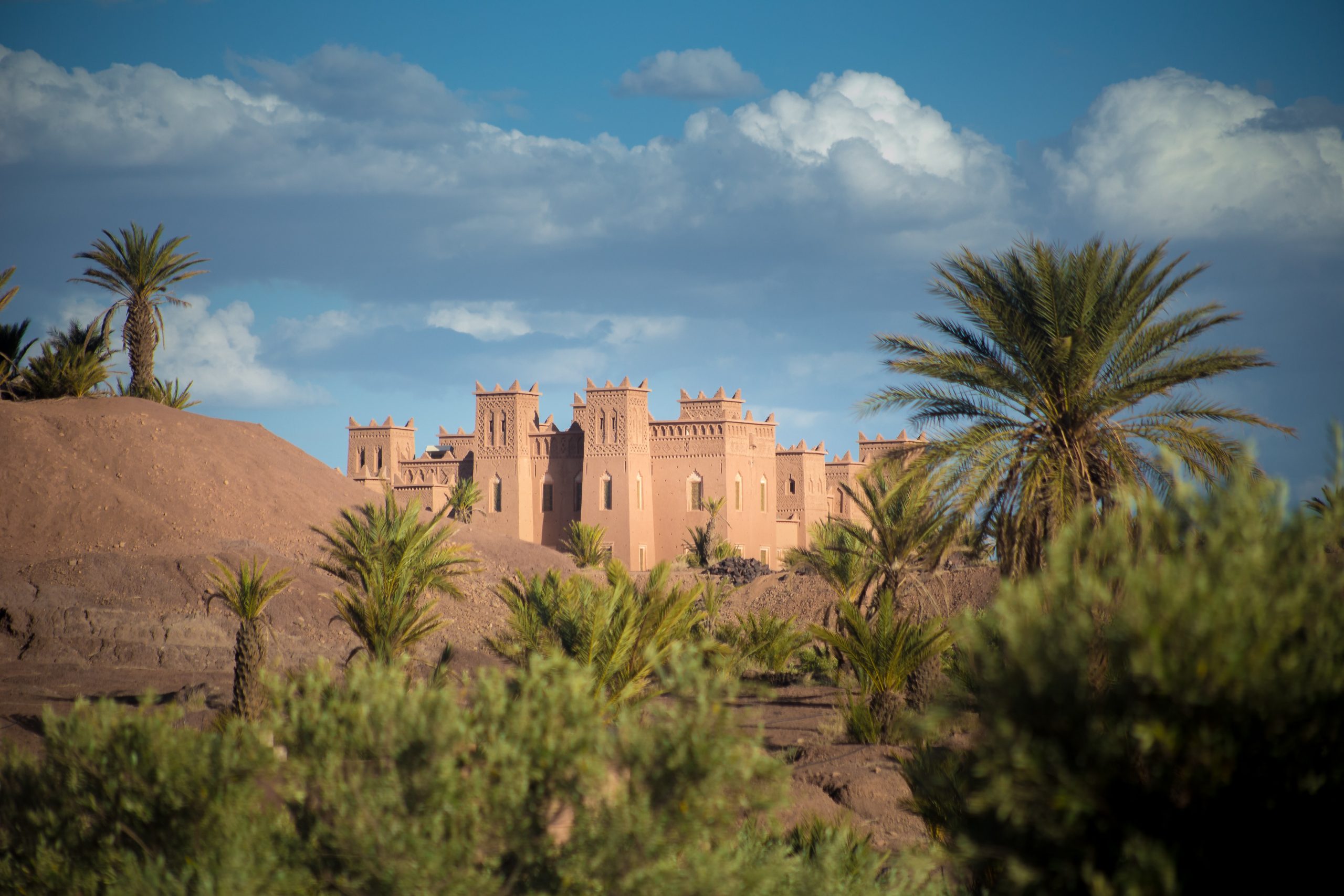
Merzouga and Erg Chebbi
A visit to Morocco without a hike through the dunes is unthinkable – and in the Erg Chebbi near Merzouga (Arab. عرق الشبي) you will find one of the two most impressive sand dune landscapes in the country, formed solely by the wind. Sand as far as the eye can see: 22 kilometers from north to south as well as five kilometers from east to west, the desert stretches with a shifting sand dune up to 150 meters high.
At the Erg Chebbi
The oasis town of Merzouga is the starting point for exploring Erg Chebbi and a desert highlight. Here the giant dunes rise to high mountains and from this point the real and seemingly endless desert begins. The desert offers the most beautiful view in the early morning hours or in the late afternoon until sunset.
Shorter Sahara trips for those in a hurry:
Tours by off-road vehicles are also possible through Morocco’s highest sand dunes. This usually starts just before sunrise and just before sunset to capture the golden light.
About 3 km west of the Merzouga oasis, in the middle of a petrified field, is a lake, Dayet Sri, where flamingos can be seen after the rains in winter. Fossil plants and animals lie scattered about.
About 25 kilometers further away from the city of Merzouga and right on the Algerian border is the date palm oasis of Taouz. In nearby Jbel Kfiroun, there are petroglyphs and several stone tumuli whose age and function no one has yet been able to clearly determine.
Merzouga Luxury Camp)
Many visitors to Merzouga book a camel ride with an overnight stay in a Berber tent, letting themselves be rocked comfortably through the pink desert from oasis to oasis, tasting the traditional Moroccan Tanjine food in the midst of nomadic life culture and watching the fascinating sunrise in the early morning. The next morning you ride back to the hotel, have breakfast, shower and leave again.
Location and arrival
Erg Chebbi is located 40 km south of the desert town of Erfoud (population just under 30,000) and immediately north of the tourist hotel town of Merzouga, from where tourists can book camel trips into the Merzouga Desert. The road from Erfoud to Merzouga is paved. Horseback riding tours can usually be booked at the hotels themselves. From the royal city of Fez, the journey by bus takes about 10 hours.
It is also possible to arrive from Erfoud via the old trading town of Rissani, formerly used as a stopping point for Saharan caravans, and stroll through the traditional souk (market alleys).
From Erg Chebbi, it is possible to drive by car road to Zagora, a larger town just before Morocco’s second interesting desert, Erg Chegaga. The nearly 300 km drive winds through the mountains and quickly the sandy desert is exchanged for rocky formations of the Atlas Mountains.
Best time to travel
The Erg Chebbi and the pink dunes of Merzouga can be visited all year round. Temperatures rise to their maximum of up to 29° Celsius between July and September. The coldest period in the region of Merzouga is from December to February with 16 to 17 ° Celsius, at night temperatures drop to 9 to 10 ° Celsius. The most pleasant seasons are spring and autumn, but this is also the high season. The summer is the low season and it is a little quieter. and you can do Casablanca desert tours
If you have rheumatic complaints, you should perhaps follow a tradition of the Moroccans – a “bath” in the early evening of the Sahara summer in the warm sand of the Erg-Chebbi dunes is said to have helped many a person against his suffering.
Comfortable camp accommodation organized travel to morocco and a perfect Morocco cultural program around it: We recommend you Marrakech desert tours
Marrakech
Located in the middle of a palm oasis, surrounded by up to 14 kilometers of red clay walls and known for its lively souks and old town – Marrakech has preserved to this day its character and charm of the old desert city and royal residence. Not only that, it is one of the most colorful cities in all of Morocco, transporting visitors to an old town maze of bazaars with oriental lamps, woven carpets and spice scents, Moorish riads and palm trees against a bright red and yellow backdrop. Find out which must-see places are on your sightseeing list and the best places to stay here!
Sights in Marrakech
Medina and the souks: the old town with its famous bazaar alleys literally transports visitors into a 1001-night atmosphere. Woven carpets, ceramics, parchment lamps, huge spice stalls in all colors are stored up to the roof in the narrow winding alleys characterized by stairs and vaults.
Each alley has its own “product”, so that the loss of orientation for tourists is limited. Here one also strolls along the many riads, city villas with leafy courtyards, for which Marrakech is famous. Riads are particularly suitable for overnight stays.
Djemaa el Fna: Under the name “Juggler Square”, all kinds of snake charmers, artists, fire-eaters and acrobats, flying merchants, herbalists, trained monkeys, cooks, and musicians meet here at the central marketplace of Marrakech to offer their services. Translated as the “gathering of the dead,” executions were carried out here just a few decades ago.
Today, the former camel transfer point, where marriages were decided with a handshake, is a favorite meeting place for tourists and locals alike, and the exoticism is enhanced by special products offered from the witchcraft of fairy tales: one can find dried lizards, toads, snake skins and magic potions.
Jardin Majorelle: Dating from the 1920s, this historic botanical garden was designed by French painter Jacques Majorelle, based on the palaces of Marrakech. It is located about 2 km northwest of the medina. Similar to André Heller’s garden artwork, there are playful watercourses and tropical plant artworks with cacti and bamboo from different climate zones to marvel at here. Also worth seeing is the former “blue studio,” which now houses the Islamic Art Museum.
ANIMA gardens: garden artwork of André Heller are a real botanical highlight in the environs of Marrakech. The sun makes the colorful botanical, exotic plant artwork shine in bright colors and no Marrakech visitor should miss this special botanical atmosphere. Admission costs EUR 12 for adults and those who purchase their ticket in advance (here). For ANIMA visitors with a printed ticket, the shuttle from Marrakech to the ANIMA garden is free.
Avenue Mohamed VI: A shopping promenade with many local stores and restaurants with a 9 kilometer park.
Bahia Palace: Built in 1867 by order of Grand Vizier Si Moussa, the imposing palace houses 160 rooms of pomp and ostentation in Andalusian and Moorish architectural styles. It is worth spending hours strolling through the historic walls and being inspired by the oriental architecture. Although the furnishings have disappeared, the ornate ornaments alone suggest much of the splendor of earlier vizier times. The Bahia Palace is located near the El-Badi Palace in the medina.
Koutoubia Mosque: With its 77-meter-high minaret built of pink sandstone, the “Mosque of the Book Trade”, located in the southern old town of Marrakech, is hard to miss. One of the oldest mosques in the country, it was built in the 12th century, and those who visit it can stroll around the spacious palm-lined forecourt. While fine stucco art adorns the architecture inside, the tower is decorated with ornate ceramic tiles.




